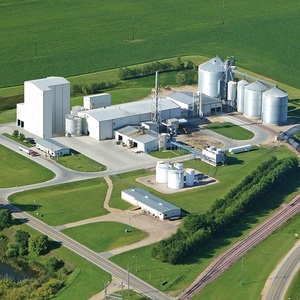Gevo collaborates with national labs on fuel, ETO projects

Gevo Inc.
October 9, 2017
BY Erin Krueger
On Oct. 9, Gevo Inc. announced two collaborations with the U.S. Department of Energy’s national labs. The company will work with Los Alamos National Laboratory to develop missile fuel and collaborate with the National Renewable Energy Laboratory, Argonne National Laboratory and Oak Ridge National Laboratory to optimize its ethanol-to-olefins (ETO) catalyst performance.
The collaboration with LANL aims to improve the energy density of certain Gevo hydrocarbon products, including its alcohol-to-jet (ATJ), to meet product specifications for tactical fuels for specialized military applications, such as RJ-4, RJ-6, and JP-10, which are currently purchased by the U.S. Department of Defense. According to Gevo, ChemCatBio, a consortium within DOE awarded funding to LANL in support of the project.
As part of the collaboration, Gevo and LANL aim to develop a cost-cost, catalytic technology that could be bolted on to Gevo’s existing isobutanol-to-hydrocarbons process to produce high energy density fuels (HEDFs), which are currently used in air and sea-launched cruise missiles used by the U.S. military forces. The fuels also have potential for use in the general aviation sector.
Advertisement
“High energy density fuels have the potential to increase the range of an aircraft or increase the payload that could be carried,” said Andrew Sutton of LANL. “That gives an obvious tactical advantage, but if this could eventually be scaled for wider use then translating these benefits to commercial airlines would have an even greater global impact.”
“Currently, certain HEDFs are supplied by limited suppliers, so the DoD is interested in supporting alternative sources of these fuels, and potentially at a lower cost,” said Patrick Gruber, CEO of Gevo. “The added benefit that this would be a renewable fuel that helps reduce greenhouse gas emissions is just icing on the cake.”
Alternatively, the collaboration with NREL, ANL and ORNL aims to fine-tune the composition of the catalyst used in Gevo’s proprietary ETO process in order to improve performance and accelerate scale-up efforts. According to Gevo, ChemCatBio also awarded funding to the national labs in support of this project.
Gevo’s ETO technology uses ethanol as a feedstock for the production of hydrocarbons, renewable hydrogen, and other chemical intermediates. The process produces tailored mixes of isobutylene, propylene, hydrogen and acetone. At this time, Gevo said its ETO technology has only been operated at the laboratory scale, but has potential to offer the ethanol industry a broader set of end-product market and margin opportunities.
Advertisement
The company also noted its catalyst is capable of converting complex mixtures of other biobased alcohols, acids and other oxygenates to primarily propylene or isobutylene along with significant levels of renewable hydrogen. According to Gevo, suitable feedstocks include difficult to process side streams from fermentation plants, biomass gasification plants, syngas plants, municipal or industrial waste processing plants, or crude petro-based chemical streams.
“We are excited to begin this collaboration with Gevo and believe that the state-of-the-art capabilities and expertise available through the Advanced Catalyst Synthesis and Characterization (ACSC) project within the ChemCatBio Consortium will enable us to gain a fundamental understanding of critical catalyst features that can change over time and impact the performance of Gevo’s ETO catalysts. We’ll use a combination of high energy X-ray characterization techniques at ANL, subatomic-resolution microscopy at ORNL, and highly sensitive vibrational spectroscopies at NREL to deliver insight into the atomic-level structure of these catalysts under reaction relevant conditions. Armed with a detailed knowledge of the “working” catalyst structure we can design and synthesize catalyst composition that have dramatically improved stability and lifetime in Gevo’s ETO process,” said Susan Habas, a Principal investigator in the ChemCatBio Consortium.
“Converting alcohols using catalytic chemistry has been key to our successes with jet fuel and isooctane. We have made good progress in developing the catalysts to convert ethanol to olefins and hydrogen,” said Gruber. “This project with the Department of Energy’s national labs is expected to help further optimize these catalysts, as well as expand the feedstock base beyond ethanol, to include a variety of water-based, organic chemical streams produced in a variety of industries. Our interest is in developing the catalysts and processes to become commercially ready, so we can license them.”
Related Stories
U.S. fuel ethanol capacity fell slightly in April, while biodiesel and renewable diesel capacity held steady, according to data released by the U.S. EIA on June 30. Feedstock consumption was down when compared to the previous month.
XCF Global Inc. on July 8 provided a production update on its flagship New Rise Reno facility, underscoring that the plant has successfully produced SAF, renewable diesel, and renewable naphtha during its initial ramp-up.
The USDA’s Risk Management Agency is implementing multiple changes to the Camelina pilot insurance program for the 2026 and succeeding crop years. The changes will expand coverage options and provide greater flexibility for producers.
EcoCeres Inc. has signed a multi-year agreement to supply British Airways with sustainable aviation fuel (SAF). The fuel will be produced from 100% waste-based biomass feedstock, such as used cooking oil (UCO).
SAF Magazine and the Commercial Aviation Alternative Fuels Initiative announced the preliminary agenda for the North American SAF Conference and Expo, being held Sept. 22-24 at the Minneapolis Convention Center in Minneapolis, Minnesota.
Upcoming Events










